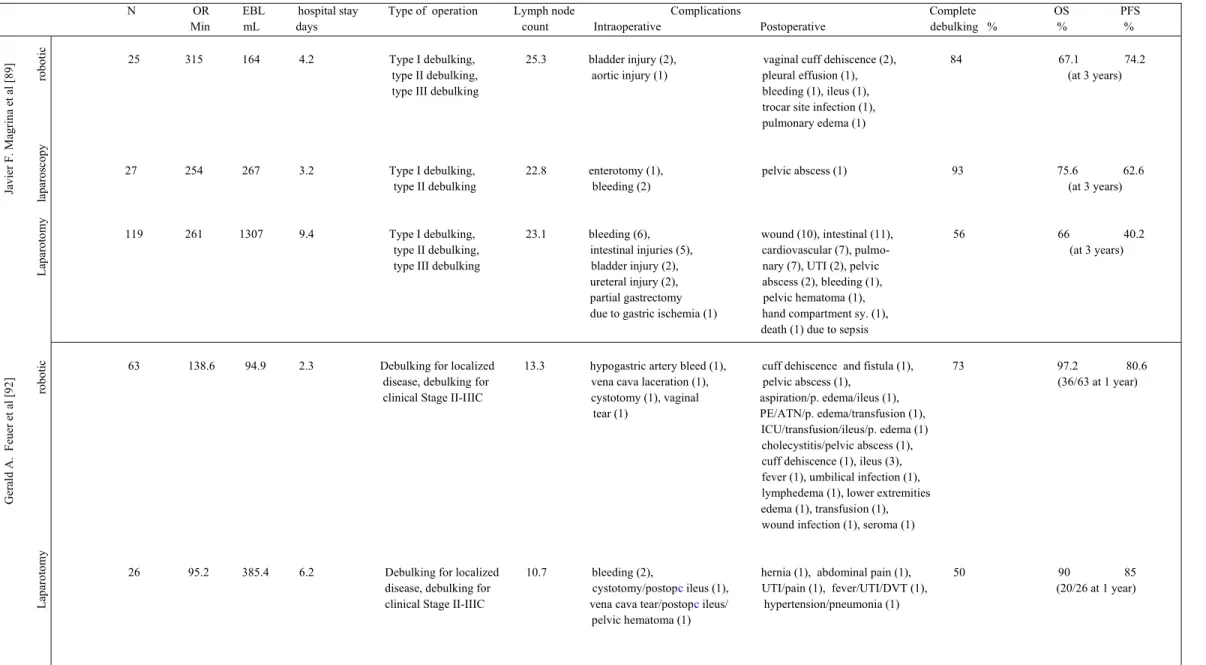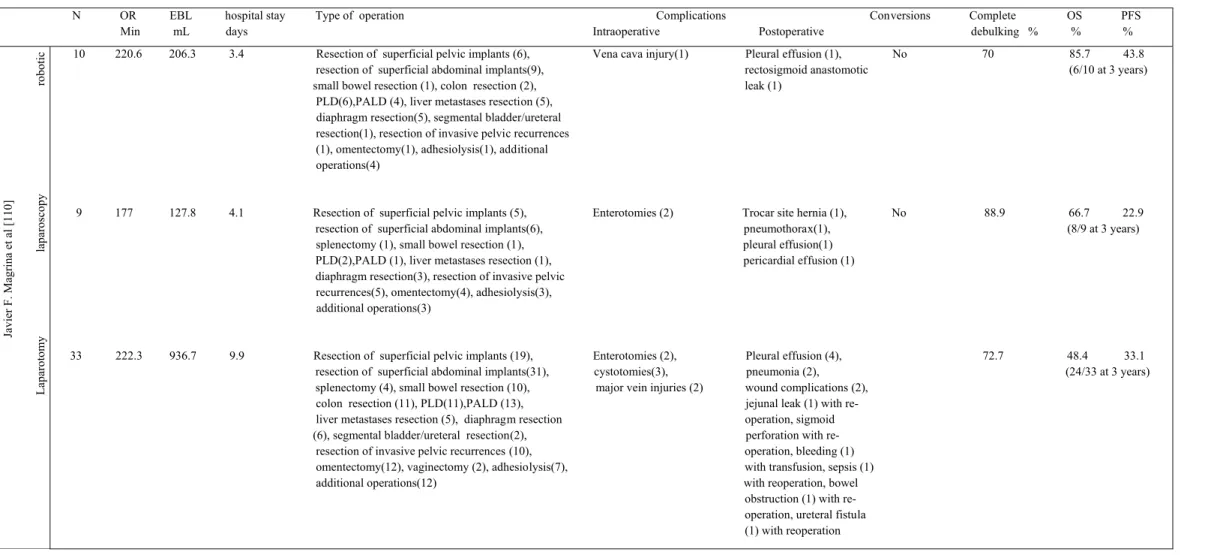Although the ovary appears to be the origin of the cancer, recent study suggested that the fallopian tube and abdominal cavity may be the sources of the disease [3]. Foot pedals located at the bottom of the console facilitate positioning of the camera, focus adjustment, activation of monopolar or bipolar energy sources, repositioning of the levers via a clutch mechanism, and switching. The second component of DRS is the InSite vision system, which provides 3D stereoscopic imaging via a 12 mm endoscope with 10 to 15 times higher magnification and high definition analysis.
The comprehensive surgical staging of the presumed early stage OC is very important because it will lead to upstage in 16% to 35% of cases [44]. So instead of the DRS having to be between the patient's legs for the pelvic part of the surgery, it is now behind the patient's head. Nezhat et al [68] developed a hybrid technique in which both conventional laparoscopy and RS are used for surgical treatment of OC.
Infrarenal lymph nodes have been reported as one of the most common sites of nodal metastases in OC [ 50 ]. In the above 3 cases, they placed the robotic platform between the patient's legs and the 12 mm optical port in a high supraumbilical position.
EARLY EXPERIENCE. MIXED AND VARIOUS OVARIAN CANER CASES
FEASIBILITY OF ROBOTIC SURGERY IN BORDERLINE OVARIAN TUMORS (BOTs) AND EARLY-STAGE OVARIAN CANCER
As previously mentioned [68] they used DRS via a hybrid technique in patients with upper and abdominal disease. BMI was greater in CL compared with RALS, and there were no differences in past medical and surgical history between the 3 groups. There is no difference between CL and RALS in estimated blood loss (EBL) or length of hospital stay (LOS), however minimally invasive techniques had significantly less EBL and LOS than LT (p<0.05).
In LT, the enterotomy was repaired with bowel resection and primary end-to-end anastomosis. Magrina et al [89] compared the perioperative and survival outcomes of RS with CL and LT for the primary surgical treatment of OC and showed reduced EBL and shorter LOS for patients with early disease undergoing type I debulking operated with RS and CL ( p <0.05). Patient characteristics, operative time, complications, overall survival (OS), and progression-free survival (PFS) were not statistically significant among the three surgical methods for type I debulking.
FEASIBILITY OF ROBOTIC SURGERY IN ADVANCED OVARIAN CANER
The authors concluded that RS and CL are preferable for patients with OC who require primary tumor excision alone or with one additional major procedure. There is potential for several biases due to heterogeneity of patients within and between the cohorts analyzed in the above study. Furthermore, the different percentages of advanced OC between the surgical groups may bias the study in favor of RS and CL.
Despite the biases, we can say that RS is feasible and safe for early stage OC and selected patients with advanced stage disease who do not require multiple major procedures without compromising the oncological outcome. Patient characteristics were matched for age, BMI and uterine weight, but previous abdominal surgery was more common in LT group (p<0.05). The authors concluded that RS is feasible and effective for the management of OC, including patients treated with neoadjuvant chemotherapy.
There are several biases such as higher percentage of patients with neoadjuvant chemotherapy and lower percentage with advanced disease in RS group and that large tumor masses were excluded from RS group. Furthermore, the proper selection of patients with extensive pre-surgical laparoscopic assessment allowed RS to be completed with a single dock in most cases. Nezhat et al [82] also compared RALS, CL and LT in advanced/recurrent OC with regard to perioperative outcomes and complication rates.
EBL was smaller and LOS shorter in RALS and CL group compared to LT group (p<0.05). It appears that in carefully selected patients of advanced/recurrent OC, CL and RALS are acceptable approaches. There was no significant difference in operative times between RALS and LT (mean 163 min vs 157 min).
The authors concluded that in appropriately selected patients with primary or recurrent OC this surgical approach is feasible and should be considered.
FEASIBILITY OF ROBOTIC SURGERY IN RECURRENT OVARIAN CANCER
Patients in the 3 surgical groups were matched by age, BMI, number of previous operations, tumor type and grade, and by the number and type of major procedures performed. Statistically significant differences were noted for decreased EBL and LOS for the RS and CL groups (p<0.05). The authors concluded that LT is more suitable for diseases involving several abdominal quadrants and in the case of widespread adhesions due to improved exposure - especially for mesenteric peritoneal implants - possibly reduced risk of bowel injury, avoidance of additional trocar placement, and -in the case of RS- the inability of the robotic arms to reach the four abdominal quadrants without redocking.
The use of RS is preferred for isolated recurrences, particularly in the diaphragms, liver, retrorectal region and pelvis. 75% of patients undergoing robotic secondary cytoreduction recurred in a single region, with 40% in the pelvis and 35% in the abdomen, and some had more than one mass within that region. For the 44 patients who underwent robotic cytoreduction, the median operative time was 180 minutes, the median EBL was 50 ml, and the median LOS was 1 day.
Estape et al [112] in their retrospective review assessed the feasibility, perioperative and survival outcomes of RS for secondary cytoreduction of recurrent OC. 84% had successful secondary debulking, which included debulking of parts of the following: organ or peritoneal surface (63%), retroperitoneum (31%), diaphragm (22%), colon resection with anastamosis or colostomy (18%), liver wedge resection ( 16%) or splenectomy (4%). Fagotti et al [113] retrospectively analyzed the feasibility of laparoscopic/robotic secondary cytoreductive surgery and hyperthermic intraperitoneal intraoperative chemotherapy (HIPEC) in a series of isolated platinum-sensitive recurrent OC.
The procedures performed for the 3 cases treated with RS were: ahesiolysis/radical omentectomy for 1 patient and radical omentectomy only for the other 2. Median operation time excl. HIPEC phase was 122 minutes, median EBL was 50 ml, median LOS was 4 days for the whole group without major differences between CL and RS. Despite the small number of cases, MIS and HIPEC are possible in isolated recurrent OC in terms of postoperative complications, blood loss and hospital stay.
There are studies supporting the role of secondary cytoreductive surgery and HIPEC in platinum sensitive recurrent OC and evidence from pharmacokinetic studies strongly support the benefit of HIPEC administration in the context of MIS [116-118].
ROBOTIC SURGERY CONCERNS FOR OVARIAN CANCER MANAGEMENT
TUMOR RUPTURE
PORT-SITE METASTASES
FUTURE OF ROBOTIC SURGERY
Finally, there will be autonomous surgeries, where part or all of the surgery is performed by a robot after the surgeon repeats the procedure, edits to make sure there are no errors, and then sends it to the robot to perform it in half the error-free time.
OBJECTIVES
MATERIAL AND METHODS
BSO=bilateral salpingo-oophorectomy; C difficile=Clostridium difficile; CIN3=cervical intraepithelial neoplasia, grade 3; EBL=estimated blood loss; H = hysterectomy; ICU=intensive care unit; LD = lymphadenectomy; LMP = low malignant potential tumor; N=number of operations; OR=operating room; PALD = para-aortic lymphadenectomy; PLD = pelvic lymphadenectomy; RH = radical hysterectomy; RT = radical trachelectomy. N OR EBL Hospital Stay Type of Surgery Lymph Node Complications Conversions Min mL Days Count Histology Intraoperative Postoperative. BOTs = borderline ovarian tumors; CL = conventional laparoscopy; EBL=estimated blood loss; FUO=fever of unknown origin; LT = laparotomy; N=number of operations; OR=operating room; RALS=robot-assisted laparoscopy.
N OR EBL Hospital Stay Type of Surgery Lymph Node Complications Complete OS PFS Min mL Days Count Intraoperative Postoperative Debulking. PFS = progression-free survival; sy.=syndrome; type I debulking= hysterectomy, adnexectomy, omentectomy, pelvic and aortic lymphadenectomy, appendectomy and removal of metastatic peritoneal disease if present; type II debulking= type I debulking and an additional major procedure; type III debulking = type I debulking and 2 or more major procedures (modified posterior pelvic exenteration with low colorectal anastomosis, sigmoid resection with. N OR EBL hospital stay Type of operation Complications Conversions Complete OS PFS Min mL days Intraoperative Postoperative debulking.
N OR EBL Hospital Recurrence Type of Surgery Complications Conversions Complete OS PFS Min ml Days Sites Intraoperative Postoperative Debulking % m. EBL=Estimated Blood Loss; N=number of operations; OR=operating room; OS=overall survival; PALD=paraaortic lymphadenectomy, PFS=progression-free survival; PLD=pelvic lymphadenectomy; PTX=pneumothorax.

DISCUSSION
CONCLUSION
ABSTRACT
Surgical outcomes of robot-assisted surgical staging for endometrial cancer are equivalent to traditional laparoscopic staging in a minimally invasive surgical center. Robot-assisted hysterectomy for endometrial cancer compared to traditional laparoscopic and laparotomy approaches: a systematic review. Tumor residual after surgical cytoreduction as a predictor of clinical outcome in stage IV epithelial ovarian cancer: a gynecologic oncology group study.
Role of surgical outcome as a prognostic factor in advanced epithelial ovarian cancer: a combined exploratory analysis of 3 prospective randomized phase 3 multicenter trials; of the Arbeitsgemeinschaft Gynaekologische Onkologie Studiengruppe Ovariankarzinom (AGO-OVAR) and Groupe d’ Investigateurs Nationaux pour les. Robotic surgery in gynecologic oncology: program initiation and first-year outcomes compared with laparotomy for endometrial cancer staging. Secondary cytoreductive surgery for localized, recurrent epithelial ovarian cancer: analysis of prognostic factors and survival outcome.
Robotic approach to ovarian cancer: Perioperative and survival outcomes and comparison with laparoscopy and laparotomy. Perioperative and clinical outcomes in the management of epithelial ovarian cancer using a robotic or abdominal approach. Robotic approach to ovarian-fallopian tube cancer Surgical staging and secondary palliative surgery for focal recurrent ovarian cancer.
The role of secondary cytoreductive surgery in the treatment of patients with recurrent epithelial ovarian carcinoma. Feasibility and perioperative outcomes of robot-assisted surgery in the management of recurrent ovarian cancer: A multi-institutional study. Cytoreductive surgery plus HIPEC in recurrent platinum-sensitive ovarian cancer patients: a case-control study on patient survival with two-year follow-up.
Robot-assisted laparoscopic cytoreductive surgery for lobular carcinoma of the breast metastasizing to the ovaries. Effect of different pressures and exposure times of a simulated carbon dioxide pneumoperitoneum environment on proliferation and apoptosis of human ovarian cancer cell lines.



